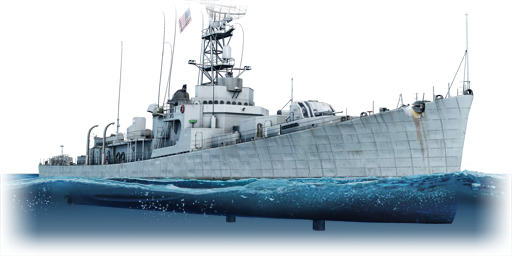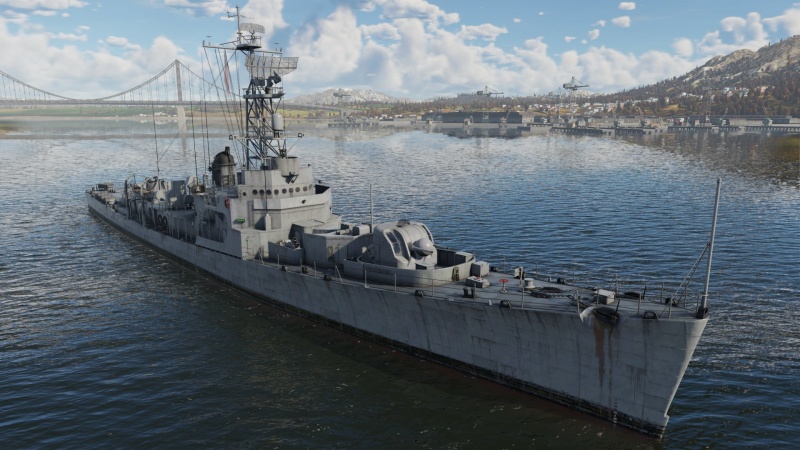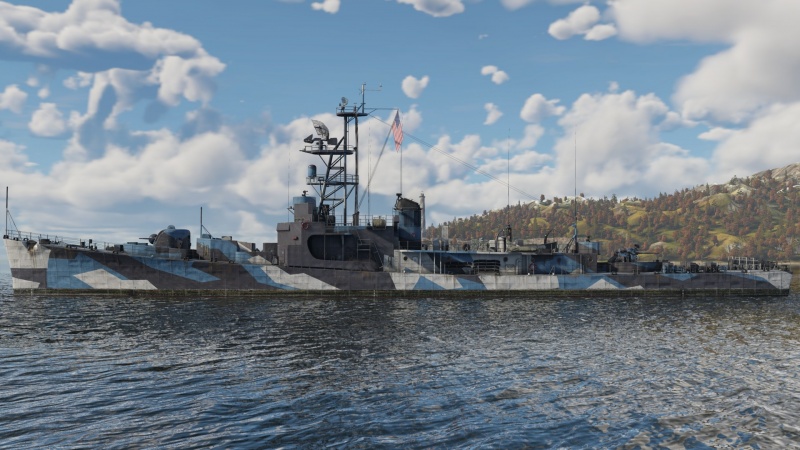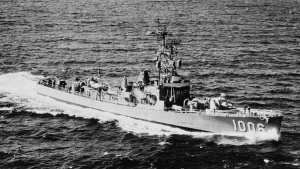Difference between revisions of "USS Dealey"
Jareel_Skaj (talk | contribs) |
Jareel_Skaj (talk | contribs) (+ side-profile) |
||
| Line 1: | Line 1: | ||
{{Specs-Card | {{Specs-Card | ||
|code=us_frigate_dealey | |code=us_frigate_dealey | ||
| − | |images={{Specs-Card-Image|GarageImage {{PAGENAME}}.jpg}} | + | |images={{Specs-Card-Image|GarageImage {{PAGENAME}}.jpg|GarageImage {{PAGENAME}} 2.jpg}} |
}} | }} | ||
Latest revision as of 21:23, 5 October 2024
Contents
Description
The USS Dealey (DE-1006), launched in November 1953 by Bath Iron Works in Maine, commissioned in June 1954, was the prototype of a new class of modern oceanic anti-submarine escorts. Stationed in Newport, she conducted naval exercises, served with the Fleet Sonar School in Key West, and participated in Caribbean convoy operations during her initial years. In 1957, Dealey embarked on a South American cruise and later took part in NATO exercise Strikeback in the Irish Sea, also visiting the ports in England and France. In May 1958, she sailed to the Mediterranean as the flagship of Escort Squadron 10, patrolling during the Lebanon crisis. After various exercises and overhauls, including a significant voyage around South America in 1960 where she visited numerous countries and exercised with their navies, Dealey continued her operations until she was decommissioned and transferred to the Uruguayan Navy on 28 July 1972. Recommissioned as ROU 18 de Julio (DE-3), the highlight of her Uruguayan career was participation in joint Brazilian-Uruguayan Operation Amigos 83 in July 1983. She was finally scrapped in 1991.
Introduced in Update "Alpha Strike", Dealey-class, USS Dealey (DE-1006) is an American frigate, featuring good mobility and a capable 3-inch main gun, but at the same time lacking anti-air armament or torpedoes, making her a challenging vessel to play, often being outclassed by even lower BR frigates, and requiring players to pay attention to all of their surroundings, including aerial threats and motor torpedo boats. Her primary role as an ASW vessel doesn't have an existing niche in the game, given the lack of submarines and many of her electronic systems not being represented in the game.
General info
Survivability and armour
Talk about the vehicle's armour. Note the most well-defended and most vulnerable zones, e.g. the ammo magazine. Evaluate the composition of components and assemblies responsible for movement and manoeuvrability. Evaluate the survivability of the primary and secondary armaments separately. Don't forget to mention the size of the crew, which plays an important role in fleet mechanics. Save tips on preserving survivability for the "Usage in battles" section. If necessary, use a graphical template to show the most well-protected or most vulnerable points in the armour.
Mobility
Write about the ship's mobility. Evaluate its power and manoeuvrability, rudder rerouting speed, stopping speed at full tilt, with its maximum forward and reverse speed.
| Mobility Characteristics | |||
|---|---|---|---|
| Game Mode | Upgrade Status | Maximum Speed (km/h) | |
| Forward | Reverse | ||
| AB | |||
| Upgraded | 70 | 35 | |
| RB/SB | |||
| Upgraded | 50 | 25 | |
Modifications and economy
Armament
Primary armament
Provide information about the characteristics of the primary armament. Evaluate their efficacy in battle based on their reload speed, ballistics and the capacity of their shells. Add a link to the main article about the weapon: {{main|Weapon name (calibre)}}. Broadly describe the ammunition available for the primary armament, and provide recommendations on how to use it and which ammunition to choose.
| Penetration statistics | |||||||
|---|---|---|---|---|---|---|---|
| Ammunition | Type of warhead |
Penetration @ 0° Angle of Attack (mm) | |||||
| 100 m | 1,000 m | 2,000 m | 3,000 m | 4,000 m | 5,000 m | ||
| HC Mk.27 | HE | 8 | 8 | 8 | 8 | 8 | 8 |
| APHE | APHE | 121 | 98 | 77 | 61 | 49 | 39 |
| Shell details | ||||||||||||
|---|---|---|---|---|---|---|---|---|---|---|---|---|
| Ammunition | Type of warhead |
Velocity (m/s) |
Projectile mass (kg) |
Fuse delay (s) |
Fuse sensitivity (mm) |
Explosive mass (TNT equivalent) (g) |
Ricochet | |||||
| 0% | 50% | 100% | ||||||||||
| HC Mk.27 | HE | 823 | 5.9 | 0 | 0.1 | 500 | 79° | 80° | 81° | |||
| APHE | APHE | 823 | 5.9 | 0.01 | 4 | 63.7 | 47° | 60° | 65° | |||
| Proximity-fused shell details | ||||||||||||
|---|---|---|---|---|---|---|---|---|---|---|---|---|
| Ammunition | Type of warhead |
Velocity (m/s) |
Projectile mass (kg) |
Fuse delay (m) |
Fuse sensitivity (mm) |
Arming distance (m) |
Trigger radius (m) |
Explosive mass (TNT equivalent) (g) |
Ricochet | |||
| 0% | 50% | 100% | ||||||||||
| AA Mk.31 | HE-VT | 823 | 5.85 | 0 | 0.1 | 548 | 15 | 352.8 | 79° | 80° | 81° | |
Additional armament
Describe the available additional armaments of the ship: depth charges, mines, torpedoes. Talk about their positions, available ammunition and launch features such as dead zones of torpedoes. If there is no additional armament, remove this section.
Usage in battles
Describe the technique of using this ship, the characteristics of her use in a team and tips on strategy. Abstain from writing an entire guide – don't try to provide a single point of view, but give the reader food for thought. Talk about the most dangerous opponents for this vehicle and provide recommendations on fighting them. If necessary, note the specifics of playing with this vehicle in various modes (AB, RB, SB).
Pros and cons
Summarise and briefly evaluate the vehicle in terms of its characteristics and combat effectiveness. Mark its pros and cons in the bulleted list. Try not to use more than 6 points for each of the characteristics. Avoid using categorical definitions such as "bad", "good" and the like - use substitutions with softer forms such as "inadequate" and "effective".
Pros:
Cons:
History
The USS Dealey (DE-1006) was the lead ship of a new class of Cold War-era destroyer escorts for the United States Navy. Launched on 8 November 1953 by Bath Iron Works in Maine and commissioned on 3 June 1954, the Dealey class was designed with the specific purpose of anti-submarine warfare capability and fast convoy escort through the Atlantic and Pacific, as well as rapid construction if tensions with the Soviet Union escalated to all-out war. The ship featured advanced electronic equipment for its time and had an all-aluminium superstructure which reduced weight by 40%, allowing for greater speed and manoeuvrability. The Dealey class had an unusual design for the time, with a single engine room, a single screw, and twin rudders, making her faster and cheaper to manufacture.
In her early years, the Dealey was based in Newport, Rhode Island, where she conducted local exercises and served with the Fleet Sonar School in Key West, Florida. Between 1954 and 1956, she participated in convoy exercises in the Caribbean. On 4 January 1957, she embarked on a South American tour, returning on 21 March to join exercises along the Atlantic coast. Later that year, in September and October, the Dealey took part in NATO exercise "Strikeback" in the Irish Sea, visiting Plymouth in England and the French ports of Brest and Cherbourg.
On 12 May 1958, the Dealey sailed for the Mediterranean as the flagship of Escort Squadron 10, screening the aircraft carrier USS Wasp (CV-18) during operations with the 6th Fleet. She patrolled the eastern Mediterranean amidst the Lebanon crisis before returning to Newport on 7 October. In early 1959, she journeyed to Guantanamo Bay for exercises and then transited the Panama Canal for goodwill visits to Colombia, Ecuador, Peru, and Chile, engaging in joint exercises with their navies. Later that year, she participated in additional NATO exercises, visiting numerous ports in Northern Ireland, England, and Portugal.
USS Dealey continued her operational duties into the 1960s, including a significant voyage around South America beginning on 22 August 1960. During this deployment, she visited numerous countries, including Trinidad, Venezuela, Ecuador, Peru, Chile, Argentina, Uruguay, and Brazil. After returning to Newport on 13 December, she remained active until her decommissioning from the US Navy on 28 July 1972 and recommissioning for the Uruguayan Navy as ROU 18 de Julio (DE-3) on the same day.
Under the Uruguayan flag, the 18 de Julio underwent a major refit from 1979 to 1980 at the Arsenal de Marinha in Rio de Janeiro, Brazil. The highlight of her service with Uruguay was her participation in Operation Amigos 83 in July 1983, a joint naval exercise conducted along the Uruguayan coast alongside the Uruguayan ship ROU Artigas and Brazilian ships Mariz e Barros, Maranhão, and Bahia. This training aimed to increase the interoperability between the Uruguayan and Brazilian navies. She continued her service until her scrapping in 1991.
Media
Excellent additions to the article would be video guides, screenshots from the game, and photos.
See also
Links to articles on the War Thunder Wiki that you think will be useful for the reader, for example:
- reference to the series of the ship;
- links to approximate analogues of other nations and research trees.
External links
- [Wikipedia] USS Dealey
- [Naval History and Heritage Command] danfs » D » Dealey
- [NavSource Naval History] Destroyer Escort Photo Archive - USS Dealey (DE 1006)
- [Home of the Newport Dealeys] USS Dealey
| Bath Iron Works | |
|---|---|
| Patrol Torpedo Boat (PT) | |
| 89’ Experimental PT | PT-810 |
| Destroyer Escorts (DE) | |
| Dealey-class | USS Dealey |
| Gun Destroyers (DD) | |
| Wickes-class | HMS Montgomery* |
| Somers-class | USS Davis |
| Gearing-class | USS Frank Knox |
| Destroyer Leaders (DL) | |
| Mitscher-class | USS Mitscher |
| *USS Wickes in UK service | |
| USA frigates | |
|---|---|
| Tacoma-class | USS Hoquiam |
| Dealey-class | USS Dealey |
| Buckley-class | USS Coolbaugh |







